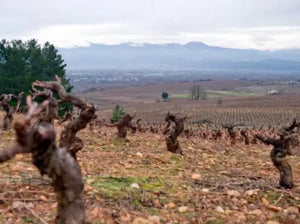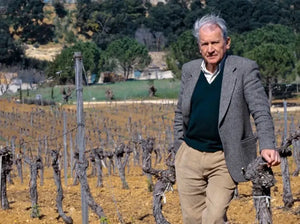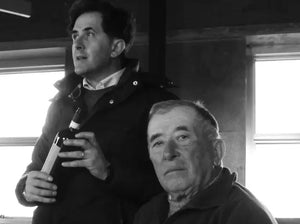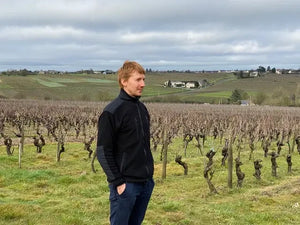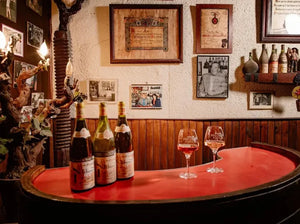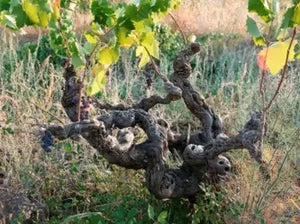Blog » Old Vines
-
Spanish Mic Drop: Raul Perez Atalier
It's hard to comprehend how one producer, like Raul Perez, can redefine the Spanish white wine category. His most monumental wine is Sketch, an Albariño sourced from a 0.5-hectare parcel of old vines in Rias Baixas, priced at $100-plus per bottle. It's worth its weight in gold, but upon release, rumors swirled that his other Albariño was going to be the proverbial mic drop moment for the variety.
Our go-to Atalier bottling, "A Cruz das Animas" comes from two parcels of Albariño vines in the Cambados area of the Salnés Valley, located in the southern portion of Spain's northwest tip. And today, we're adding "La Encrucijada" from Atalier's oldest and most sea-adjacent vines, which sees extended aging in barrel (About 14 months) on its fine lees before bottling. Raul's greatest influence is white Burgundy, and he takes every step possible to preserve Albariño's cut and delineation iwhile also pushing for maximum ripeness and flavor development.
The key steps are harvesting very late and then blocking malolactic fermentation, which allows for superb ripeness but eliminates the more viscous and creamy elements of Albariño that don't appeal to Raul. Aging is in older French foudre, which preserves tension and softens texture. Perez redefines what a mineral-driven Spanish white wine is capable of, showing the same depth and nuance I expect from Chablis and Côte de Beaune Chardonnay. Simply put, his Atalier over-delivers. -
Languedoc's Jewel: Mas de Daumas Gassac
Outside of the iconic Cabernet Sauvignon addresses in Bordeaux, there's one name in France that can go toe to toe with these chateaux: Mas de Daumas Gassac. As always, the provenance of older wines is a critical factor in the quality you'll find in the glass, and I'm thrilled to offer this mint condition collection from Languedoc's star estate.
Mas de Daumas Gassac was established in 1970 when Véronique and Aimé Guibert came across an abandoned farmhouse owned by the Daumas family along the Gassac River in the Herault. Underground water springs and surrounding mountains created a microclimate mirroring Bordeaux's Médoc, so they planted vine material from First Growth chateaux in Bordeaux. The region has an abundance of 100-plus-year-old plantings, with a dry climate favorable for organic viticulture.
Made of 70% Cabernet Sauvignon supplemented with Cabernet Franc, Merlot, Pinot Noir, Tannat, and Malbec, the wines highlight espresso, dark chocolate, cigar box, brambly blackberries, and savory spices. Still, Languedoc's cooling influences and limestone bedrock have long stood out as a beacon for freshness. Alcohol levels have remained modest through stylistic shifts, never taking Bordeaux's cues when things drastically changed in the '80s. -
Trebbiano on the Skins: Paolo Bea Arboreus Bianco
Paolo Bea is most famous for its wildly interesting take on Montefalco's Sagrantino red grape variety, but today, I’d like to pivot to their orange wines. Paolo's son, Giampiero, was one of the first naturalists in Italy to adopt the practices of Josko Gravner and Stanko Radikon (the Friulian winemakers who repopularized the ancient-old tradition of fermenting white grapes on their skins). Today, Bea’s Arboreus is considered a benchmark in the world of orange wine, and it has a fascinating backstory.
These Trebbiano Spoletino vines were planted below oak trees on the Paolo Bea estate over 120 years ago and have completely wrapped themselves around the trees (Hence the name Arboreus). Once harvested and de-stemmed, the grapes ferment on the skins for several weeks and spend a minimum of two years on the lees in stainless steel tanks. Gravner and Radikon produce the most concentrated, structured examples of orange wine you’ll come across and are undoubtedly the pinnacles in this category. I more often gravitate toward Paolo Bea's style, though. Arboreus has that same deep amber hue, golden stone fruit showing apricot and yellow plum, powerful tannins—but with an added streak of freshness that balances its other components. Note: This is a great food wine with the tannins to take one heavier foods than typical whites (Lamb kabobs and saffron rice were on my mind when we tasted this).
If you prefer your orange wines, well, less orange-y, consider Lapideus. The grape variety, soil type, and winemaking are the same as Arboreus (same skin-contact and élevage regimen). Except, these 80-year-old Trebbiano Spoletino vines, trained in the traditional cordon method, grow in a cooler microclimate, resulting in a leaner, more acid-driven orange wine. Paolo Bea provides a counterpoint to the argument that this style of wine can’t be terroir-driven! There are also Monastero Suore Cistercensi’s orange wines, Coenobium and Ruscum, as value-driven options. Based in Lazio, these wines are farmed and produced by the Sisters of the Cistercian order, with some guidance from Giampiero.
Lastly, I highly recommend reading Giampiero's interview with Sprudge Wine, which includes a photo of those stunning Arboreus vines. If you are a skin-contact fanatic, like me, Paolo Bea is a must-try, as these were the among the defining wines for what's now a booming category. -
Anjou Outlier: Pierre Menard's Old-Vine Sauvignon Blanc
Pierre Menard reaches cult status in Europe for his lieu-dit (single-vineyard) Chenin Blancs. Simply put, Chenin gets the prime slopes in Anjou, where schist dominates, and the flatlands may see some Sauvignon Blanc. However, Menard discovered one of the first Sauvignon Blanc parcels in this region, the tiny 1957-planted Clos de la Roche atop a slope in Faye d'Anjou.
Before tasting Laïka, one should expel any notion of what this variety delivers. Typical grapefruit and lime fade into the background—much like earth did when the first living creature, a dog named Laïka, was rocketed into space in 1957—those flavors are replaced by saffron butter, a kaleidoscope of yellow fruits, and a mineral underpinning that only Anjou's schist-laden slopes convey.
Only a few cases of Laïka enter the U.S. each year. Also, do not miss Menard's stellar Chenin Blancs in equally small quantities. While we don't focus on many sweet/dessert wines, the "Cosmos" Coteaux du Layon (500 ml) blew us away. Perfect for pairing with cheese or dessert, but save the chocolate for Port! -
1793-Outlier: Provence's Clos Cibonne Rosé
That was the year the Roux family purchased the estate from Jean-Baptiste de Cibon and planted the rare goblet-trained Tibouren red variety. Tibouren is as obscure as the style of rosé that has been made here for centuries. And, the single red wine example from Cibonne is a departure stylistically from most Provence reds, as its lighter-bodied style and elegant personality strut their stuff when bottles are served chilled––a perfect summertime red.
The Cibonne rosés (five of them) are the main attraction here, and rightfully so, as they can all age and develop positively for a decade or more. Cuvée Tradition is aged in 100-year-old foudres sous-voile (under a thin veil of flor) giving faint hints of briny clementines and almonds. The fruit is not emphasized in this rosé like most, instead, notes of cardamon and anise take a prominent role next to the white peach and strawberry foundation.
If there's one thing that impresses all who drink Cibonne's rosés for the first time, it is surely the un-ending finish that lingers with spice and salty fruit thanks to the proximity of Cibonne's vines from the Mediterranean, just 800 meters away. If you've ever wanted a jolt of excitement for Provence reds or rosés, this is the historic domaine you need to try. -
Old-School Mt. Etna: Massimiliano Calabretta
“I make my wine like Bartolo Mascarello!” That's what Massimiliano Calabretta told his U.S. importer when they first visited his estate in Sicily. The family's formula is simple: To work with old-vine and own-rooted parcels preserved as long as possible through organic farming. Their historic practices have stood the test of time as the world around them rapidly changed. The wines at Calebretta are entrenched in tradition, just as Bartolo Mascarello would have approved.
Nerello Cappuccio is often considered a blending grape (mainly because of its viticulture difficulty and susceptibility to disease than any varietal shortcoming). Calabretta saw his old, ungrafted vines offered a very different expression of the variety, with an aromatic lift that stood apart from his counterparts: Dark red fruits, smoke, lavender, violets, and a saline-infused finish that has made reaching for this wine habitual.
Nerello Mascalese is the primary red variety on Mt. Etna. The vines for Calabretta's old-vine cuvée, Vigne Vecchie, start at 60 years old and go well over 100 years, many of which are un-grafted. Aging takes place in 50-70 hectoliter Slavonian casks for up to 42 months. This protocol draws parallels to traditional Barolo producers, but the similarities go beyond aging formats.
.svg?v=162776257677185172071677832259)



